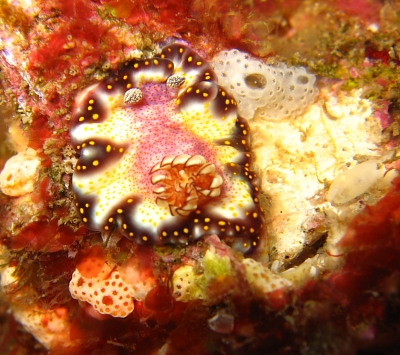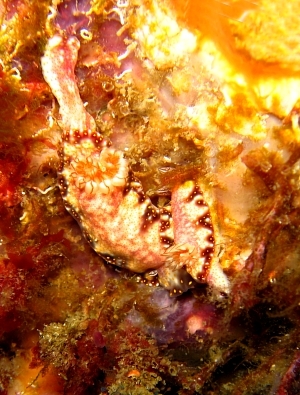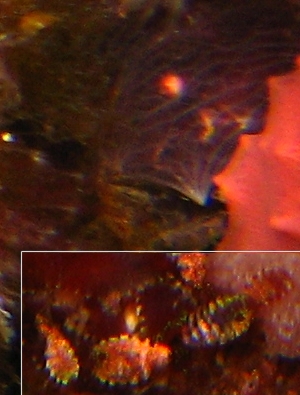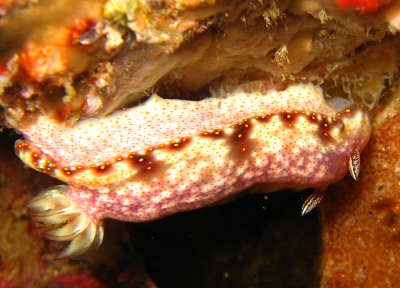Risbecia godeffroyana feeding & trailing [2]
August 29, 2006
From: Bruce Wilkie

Hi Bill,
Here are some more photos to accompany my previous message [#17600 ].
I observed the animal in the upper right photo over a period of 8 days. It was found sitting in a small hollow which was void of growth. I don`t know if it cleared (ate) the growth that was in there. Over this period it hardly moved at all and the next day it had disappeared. There was also no sign of any egg ribbons in the general area. I thought it a odd that I just stayed there and didn`t seem to do anything.
In the bottom of the middle photo there are some more animals, I am not sure if they are juvenile R. godeffroyana?
Locality: North Stradbroke Island, Queensland, Australia, Pacific Ocean. Upper right photo: Shag Rock, 3 m, 23rd April 2006, Rocky reef with hard & soft corals & sponges. Middle photos: Flat Rock, 30th June 2006. Depth 12m. Lower right photo: Flat Rock, 29th April 2006, Depth 8 m.
Photographer: Bruce Wilkie.
Many Thanks
Bruce Wilkie.
brucedwilkie@yahoo.com.au



Dear Bruce,
Thanks again. I am so glad you have found the time to look through your slides. I can't add anything to your comments on your upper photo. It looks like it just decided to take 'time out'. I haven't room to display the whole of your photo 3 so the two middle photos, and the inset, are parts of it. It is very interesting. You can see in the left photo that there are patches of purple. When you look at them carefully in your original photo there are clear signs they have been eaten. I suspect there is a large colony of this purplish sponge which is being covered by other sponges and plant growths. In the right photo, I have included a close-up of part of the purplish sponge in the hollow just to the bottom right of the other photo. This is clearly Euryspongia, which is what I suspected was the food sponge in your earlier message. So it confirms my thoughts in that message that Euryspongia colonies are the food of Risbecia godeffroyana, and they are often usually overgrown, making their presence almost impossible to detect by the casual observer.
I have added the 'other animals' possible juveniles? in an inset. Although a couple look like slugs, I suspect they are jointed animals, crustacea? or worms? I am afraid I can't say anything about the lower photo, but after the positive identification of Euryspongia in the other photo, I am not complaining.
Best wishes,
Bill Rudman
Related messages
-
Risbecia godeffroyana from Great Barrier Reef
From: Andrew Trevor-Jones, November 24, 2007 -
More Risbecia godeffroyana feeding
From: Nerida Wilson, August 30, 2006 -
Risbecia godeffroyana feeding & trailing [1]
From: Bruce Wilkie, August 29, 2006 -
Risbecia godeffroyana from Bali
From: Stuart Hutchison, March 23, 2002 -
Risbecia godeffroyana from the Solomons
From: Mary Jane Adams, January 10, 2001 -
Risbecia imperialis & R. godeffroyana
From: Bill Rudman, January 10, 2001 -
Risbecia from Solomon Ids?
From: Bruce Potter, January 8, 2001 -
Risbecia godeffroyana? from Solomon Ids
From: Mary Jane Adams, September 6, 2000 -
Risbecia imperialis from Vanuatu
From: Vinka Stenhouse, January 27, 2000
